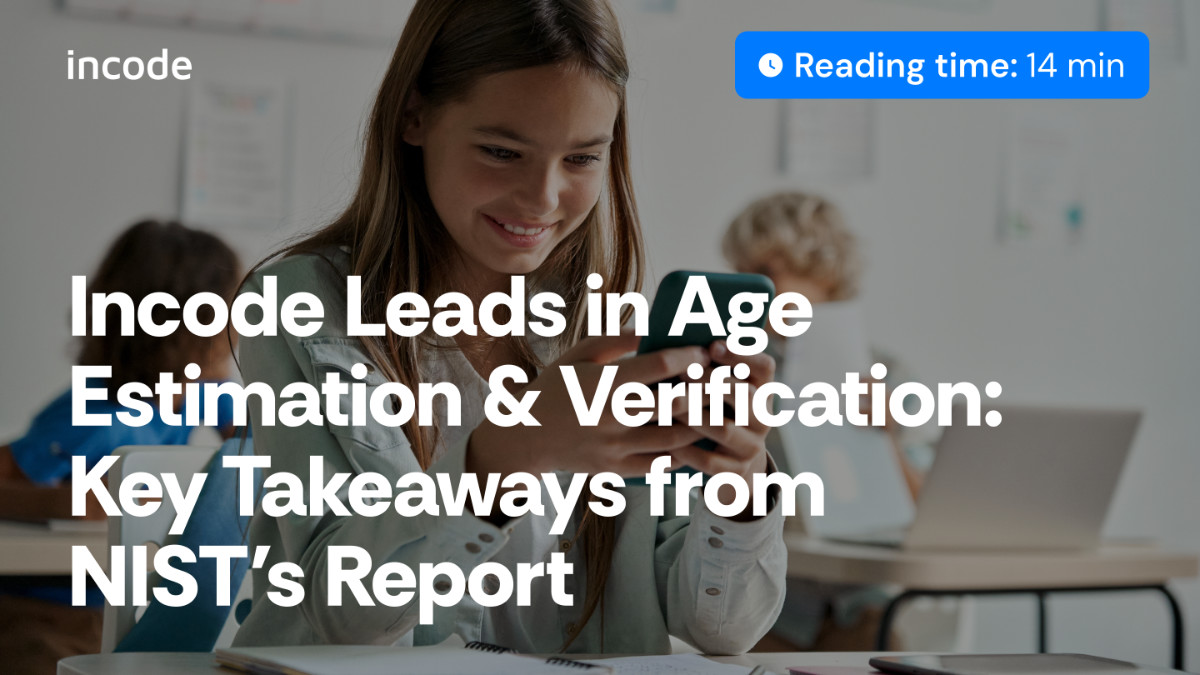Incode Leads in Age Estimation & Verification: Key Takeaways from NIST’s Report
In today’s increasingly digital world, children and teens regularly access the internet to connect with their friends, make purchases, find information, and simply have fun. But while digitization brings many benefits, it also brings risk: That age-restricted goods, content, or services could fall into the hands of users who are too young for them.
This fear is nothing new. Even 20 years ago, parents and legislatures worried about the potential harm that could result from children’s unfettered access to the internet. But that was a different time, when access was largely limited to desktop computers which could be more easily monitored by parents. Today’s youth are using laptops, tablets, smartphones, and other smart devices which have proven more difficult to monitor.
It’s little wonder, then, that much of the onus of protecting children from age-restricted goods, services, and content has shifted away from parents and onto the websites and platforms themselves. In fact, an increasing number of states and countries around the world have begun requiring online platforms to deploy processes for age estimation and verification of users — by law.
The challenge: Age verification introduces friction into the signup process, which can hurt a platform’s ability to attract and convert users. Age estimation, reliant on facial recognition and artificial intelligence (AI), introduces less friction — but can also be less accurate. This increases the risk that a certain percentage of users may be inappropriately denied access to websites and platforms, while a certain number of children and teens may inappropriately gain access.
In other words, when it comes to age estimation, accuracy matters. Businesses have a strong incentive to choose the most accurate age estimation technology available to them.
To aid in this evaluation, the National Institute of Standards and Technology (NIST) evaluates and ranks age estimation models and solutions. Incode is proud to have been recently recognized by NIST as the most accurate global age estimation solution.
Below, we take a look at the results of NIST’s study and how Incode’s age estimation technology works. We also answer other questions businesses often have about age estimation and verification.
Key Findings of the NIST FATE Report
Countless businesses in industries ranging from adult content to ecommerce to alcohol delivery, online gambling, financial services, and social media are already subject to laws and regulations requiring age estimation and verification of their users. As regulations continue to evolve, many more businesses are expected to need to join this list.
The National Institute for Standards and Technology Face Analysis Technology Evaluation (NIST FATE) report was designed to assess the accuracy and performance of algorithms used in facial analysis for a variety of use cases — including 8 algorithms used in age estimation.
Across the board, NIST found that the accuracy of age estimation algorithms, as a whole, have improved markedly since they were first evaluated in 2014 — a win for the industry at large, and for the companies depending on this technology.
Incode’s age estimation algorithm shone against the competition in a number of critical areas, including:
Top Ranking in Application Photos
Incode demonstrated the highest accuracy rates in the Application dataset, achieving a mean absolute error (MAE) of just 3.0 years. These images are reflective of typical user-uploaded images, showcasing Incode’s as an ideal solution to be integrated into online platforms and services.

Why it matters: More accurate age estimation in these applications means more genuine users being approved, converted, and ultimately monetized.
Unmatched Accuracy Across Diverse Datasets
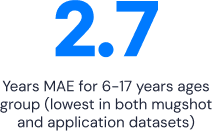
Incode achieved the lowest mean absolute error (MAE) of all algorithms evaluated — 2.7 years — for the 6-17 years age group. This performance was not limited to a single dataset, but spanned multiple image categories: Both the Mugshot and Application datasets. This shows that the algorithm doesn’t just accurately estimate age in one scenario, but in multiple scenarios using diverse datasets.
Why it matters: When it comes to compliance, the 6-17 age range is perhaps the most critical. Businesses dealing in age-restricted goods, services or content need an age estimation solution capable of differentiating between these ages.
Consistently Low Error Rates Across Image Categories
Incode’s algorithm consistently demonstrated low MAE, averaging 3.5 years across the four datasets measured — Mugshot, Border, Application, and Visa. These results demonstrate that Incode’s age estimation technology performs reliably in a wide range of real-world settings, including when faced with challenging border crossing photos and diverse image qualities.
Why it matters: Image quality in the controlled setting of a lab varies significantly from the real-world applications discussed above. Consistently low error rates in a variety of applications points to a technology that will work even when image quality is lower than ideal.
Lowest False-Positive Rates for the 14-17 and 18-20 age groups
Mean absolute error rates aren’t the only accuracy metrics evaluated by NIST. The study also measured false positive rates (FPR), also known as false acceptance. Incode’s algorithm achieved the lowest FPR of 0.047 for the Application dataset. In the crucial “Challenge 25” scenario for application images, Incode achieved the lowest FPRs for the 14-17 and 18-20 age groups.

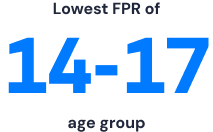
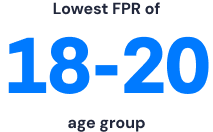
Why it matters: Low false positive rates for these two age groupings (14-17 and 18-20) demonstrate an exceptional ability to accurately distinguish between minors and adults — the whole reason age estimation technologies are needed.
How Incode’s Age Estimation Technology Works
Incode’s age estimation technology was designed to be a fast and easy-to-use means of determining whether or not a user is old enough to access a website with age-restricted goods, services, or content.
It works like this:
- Your user captures a selfie using the camera on their device.
- Security measures check to ensure that the uploaded image was actually captured through the camera in real-time, and that it is not a part of an injection attack.
- Our algorithms then analyze the image to estimate the user’s age. At the same time, liveness checks ensure that they are a real, living person and not a deepfake or other spoof.
- If your user passes, they’re allowed to move forward. If they fail, they can be automatically denied access to an account or content, or can be moved into an alternative verification flow using a document or database checks.
Of course, we understand that age estimation may not be suitable for all businesses operating in all jurisdictions. Some jurisdictions may require businesses in certain industries to implement different age verification measures; some businesses may simply want additional assurance in a user’s age in order to minimize risk even further. For these reasons, Incode offers additional age verification solutions, including database verification and ID verification.
Benefits of Incode’s Age Estimation Technology for Business
Leveraging the top-rated age estimation solution can unlock a lot of benefits for businesses operating in a number of industries from retail and e-commerce to online gambling, social media, and adult content. These benefits include:
- Reduced friction: Incode’s age estimation process takes an average of just 3 seconds from start to finish — minimizing friction without compromising compliance. Our low rate of false rejections also means that of-age users will not be unduly denied access to your website or platform.
- Increased customer satisfaction: Some of your users may be wary of sharing their government ID or sensitive data with you to verify their age. Age estimation removes this need, respecting your users’ privacy, helping you build trust, and simply providing a better experience.
- Reduced risk: With age estimation, your business doesn’t actually need to store any of your users’ sensitive information. This reduces the damage that a bad actor can inflict on your business in the case of a data breach.

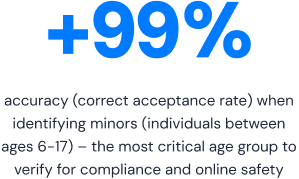
Get Age Estimation Right With Incode
As you consider various age estimation solutions, it’s important to look for a partner with a proven track record of success. Incode is proud to be leading the way in what is truly a rapidly evolving field — as evidenced by our recent NIST ratings.
“Incode delivers the seamless verification our delivery partners need for age-restricted deliveries”
DriverOps at Large US on-demand delivery service
Want to learn more about how Incode can help you deploy age verification and estimation for your business? Get in touch with an Incode Identity Consultant, or request a free demo today.
Editor’s Note:
In past years, NIST evaluated all facial recognition technologies in a single testing track known as the Face Recognition Vendor Test (FRVT). To account for the fact that facial recognition technology has multiple use cases and applications, NIST has broken this testing out into two separate tracks: The Face Recognition Technology Evaluation (FRTE) and Face Analysis Technology Evaluation (FATE). The results discussed above came from NIST’s FATE evaluation for 2024.
